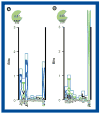Predictions versus high-throughput experiments in T-cell epitope discovery: competition or synergy?
- PMID: 22149708
- PMCID: PMC3297080
- DOI: 10.1586/erv.11.160
Predictions versus high-throughput experiments in T-cell epitope discovery: competition or synergy?
Abstract
Prediction methods as well as experimental methods for T-cell epitope discovery have developed significantly in recent years. High-throughput experimental methods have made it possible to perform full-length protein scans for epitopes restricted to a limited number of MHC alleles. The high costs and limitations regarding the number of proteins and MHC alleles that are feasibly handled by such experimental methods have made in silico prediction models of high interest. MHC binding prediction methods are today of a very high quality and can predict MHC binding peptides with high accuracy. This is possible for a large range of MHC alleles and relevant length of binding peptides. The predictions can easily be performed for complete proteomes of any size. Prediction methods are still, however, dependent on good experimental methods for validation, and should merely be used as a guide for rational epitope discovery. We expect prediction methods as well as experimental validation methods to continue to develop and that we will soon see clinical trials of products whose development has been guided by prediction methods.
Conflict of interest statement
The authors have no other relevant affiliations or financial involvement with any organization or entity with a financial interest in or financial conflict with the subject matter or materials discussed in the manuscript apart from those disclosed.
No writing assistance was utilized in the production of this manuscript.
Figures


Similar articles
-
Major histocompatibility complex linked databases and prediction tools for designing vaccines.Hum Immunol. 2016 Mar;77(3):295-306. doi: 10.1016/j.humimm.2015.11.012. Epub 2015 Nov 14. Hum Immunol. 2016. PMID: 26585361
-
Major histocompatibility complex class I binding predictions as a tool in epitope discovery.Immunology. 2010 Jul;130(3):309-18. doi: 10.1111/j.1365-2567.2010.03300.x. Epub 2010 May 26. Immunology. 2010. PMID: 20518827 Free PMC article. Review.
-
Systematically benchmarking peptide-MHC binding predictors: From synthetic to naturally processed epitopes.PLoS Comput Biol. 2018 Nov 8;14(11):e1006457. doi: 10.1371/journal.pcbi.1006457. eCollection 2018 Nov. PLoS Comput Biol. 2018. PMID: 30408041 Free PMC article.
-
High-Throughput Identification of MHC Class I Binding Peptides Using an Ultradense Peptide Array.J Immunol. 2020 Mar 15;204(6):1689-1696. doi: 10.4049/jimmunol.1900889. Epub 2020 Feb 14. J Immunol. 2020. PMID: 32060132 Free PMC article.
-
Prediction of MHC-peptide binding: a systematic and comprehensive overview.Curr Pharm Des. 2009;15(28):3209-20. doi: 10.2174/138161209789105162. Curr Pharm Des. 2009. PMID: 19860671 Review.
Cited by
-
Immunoregulatory T cell epitope peptides: the new frontier in allergy therapy.Clin Exp Allergy. 2015 Jun;45(6):1015-26. doi: 10.1111/cea.12554. Clin Exp Allergy. 2015. PMID: 25900315 Free PMC article. Review.
-
T-cell epitopes predicted from the Nucleocapsid protein of Sin Nombre virus restricted to 30 HLA alleles common to the North American population.Bioinformation. 2017 Mar 31;13(3):94-100. doi: 10.6026/97320630013094. eCollection 2017. Bioinformation. 2017. PMID: 28584450 Free PMC article.
-
DynaDom: structure-based prediction of T cell receptor inter-domain and T cell receptor-peptide-MHC (class I) association angles.BMC Struct Biol. 2017 Feb 2;17(1):2. doi: 10.1186/s12900-016-0071-7. BMC Struct Biol. 2017. PMID: 28148269 Free PMC article.
-
Therapeutic cancer vaccines for pediatric malignancies: advances, challenges, and emerging technologies.Neurooncol Adv. 2021 Feb 11;3(1):vdab027. doi: 10.1093/noajnl/vdab027. eCollection 2021 Jan-Dec. Neurooncol Adv. 2021. PMID: 33860227 Free PMC article. Review.
-
Riding the wave of innovation: immunoinformatics in fish disease control.PeerJ. 2023 Dec 8;11:e16419. doi: 10.7717/peerj.16419. eCollection 2023. PeerJ. 2023. PMID: 38089909 Free PMC article. Review.
References
-
- Sette A, Peters B. Immune epitope mapping in the post-genomic era: lessons for vaccine development. Curr Opin Immunol. 2007;19:106–110. - PubMed
-
- Ottenhoff TH, Doherty TM, van Dissel JT, et al. First in humans: a new molecularly defined vaccine shows excellent safety and strong induction of long-lived Mycobacterium tuberculosis-specific Th1-cell like responses. Hum Vaccin. 2010;6:1007–1015. - PubMed
Websites
-
- NetMHCcons. www.cbs.dtu.dk/services/NetMHCcons/
-
- Safety Study of Cancer Specific Epitope Peptides Cocktail for Cervical, GI, and Lung Tumors (peptidevac) http://clinicaltrials.gov/ct2/show/NCT00676949.
-
- HLA-A*0201 Restricted Peptide Vaccine Therapy With Gemcitabine With Gemcitabine in Patient Pancreatic Cancer (Phase 1) http://clinicaltrials.gov/ct2/show/NCT01266720.
-
- Vaccine Therapy in Treating Patients With Breast Cancer. http://clinicaltrials.gov/ct2/show/NCT00524277.
-
- PDB HLA-A*11:01 structure, 2HN7. http://dx.doi.org/10.2210/pdb2hn7/pdb. - DOI
Publication types
MeSH terms
Substances
Grants and funding
LinkOut - more resources
Full Text Sources
Other Literature Sources
Research Materials
